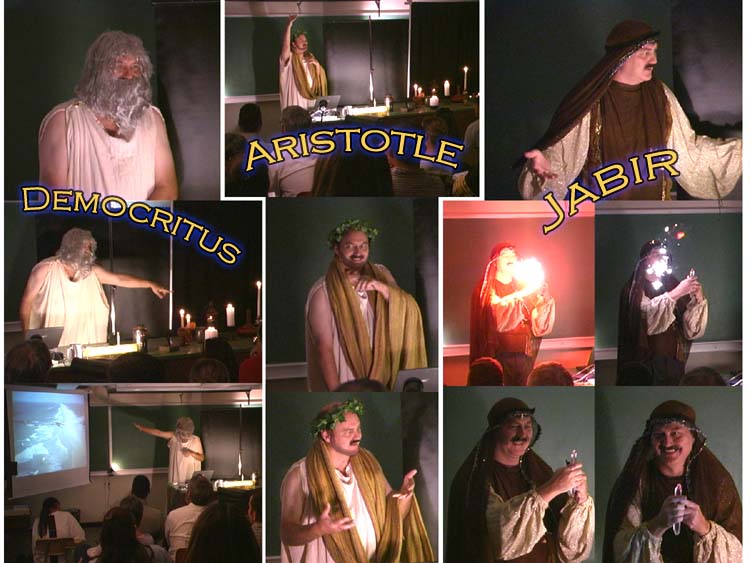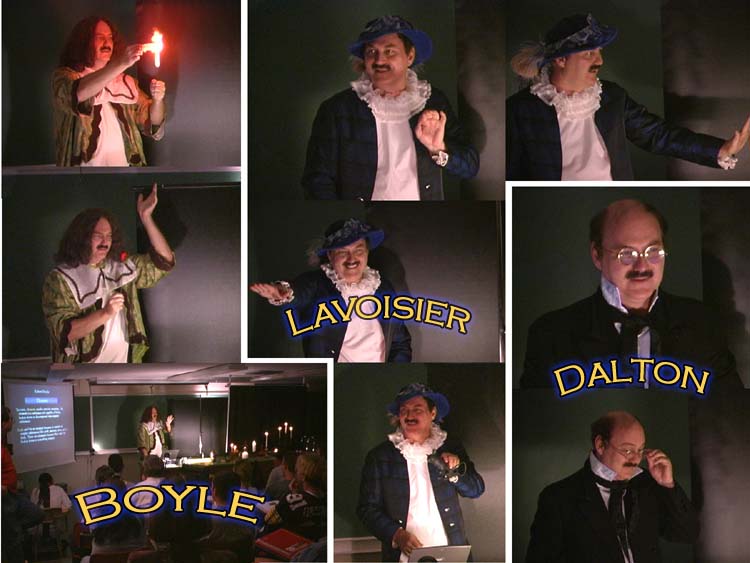
| The below images are from a 1 hour presentation of the history of chemistry given by chemistry instructor, Ken Costello. It was a combination of theatrics, multimedia PowerPoint, magic tricks, and chemistry demos. Utilizing quick changing of costumes and self-running PowerPoints, the show moved at a quick pace of 2,000 years per hour. |
 |
||
| Democritus in 400 B.C. proposed a theory that everything was make from atoms. He chose the word "atom" because it meant indivisible. He felt that elements could only be divided down so far until they reached their smallest size, which he called an atom. | Sixty years later Aristotle denounced the atom because he felt you couldn't put a limitation on the gods. If they wanted to divide an element smaller than an atom, they could. Aristotle also proposed a 5th element, which he said the celestial bodies were made of. It was so perfect that it could turn common metals into gold and provide an elixir of everlasting youth and health. This started the whole branch of alchemy. | In 776 A.D. Jabir Ibn Haiyan, an Arabic alchemist, did more than just look for the 5th element. He developed laboratory equipment and procedures for practical chemistry. The distillation apparatus was just one of many. He's often looked upon as the father of chemistry. |
 |
||
| In 1661 Robert Boyle of England was one of the earliest chemists. He accused the alchemists as being tricksters, mystics, or misguided fools. He studied gases and learned certain laws that governed their behavior | In 1793 Antoine Laurent Lavoisier from France was known as the father of modern chemistry. He wrote the first chemistry textbook and discovered the secret to combustion. | In 1796 John Dalton, an Englishman, resurrected the idea of the atom and proposed how elements combined to form compounds. |
 |
|||
| Amadeo Avogadro studied gases and proposed that any two gases of the same volume had equal number of atoms. This led to finding the relative weights of elements. | Robert Wilhem Eberhard Bunsen was sprinkling different powders into a flame and examining the light after it passed through a prism. He invented the Bunsen burner in order to get a cleaner and clearer flame. | John Newlands discovered that the behaviors of elements repeated themselves. He said every 8th element was similar to the 8th element before it and after it. He called it the Law of Octaves because of the similarity to musical octaves. | Dmitri Ivanovich Mendeleev agreed with Newlands but developed a more complete chart that was arranged so that elements that had similar properties would be grouped. This led to our modern Periodic Chart of the Elements. |
 This is me (Ken Costello) in Yellowstone Jan 9, 2004 |
|